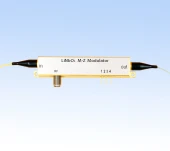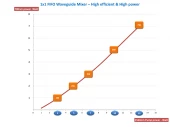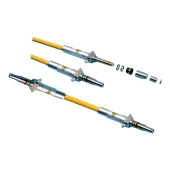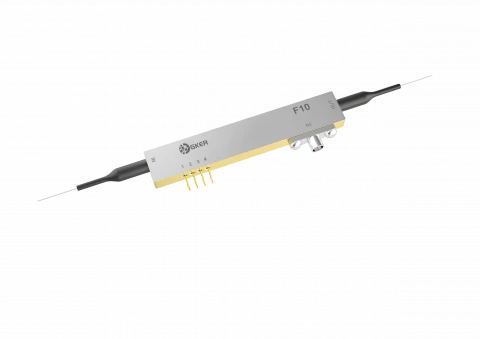Description
The GKER Photonics C-Band 10 GHz High Bandwidth Zero-Chirp LiNbO₃ Intensity Modulator (F10) is a cutting-edge solution designed for high-speed optical communication systems. Built using the highly reliable Mach-Zehnder Interferometer (MZI) architecture on an X-Cut, Y-Propagating lithium niobate substrate, this modulator provides exceptional performance for advanced metro to long-haul communication systems.
The F10 modulator features a Zero-Chirped design, enabling superior signal integrity at high bit rates of up to 12.5 Gb/s, making it ideal for external intensity modulation applications. Integrated with a monitor photodiode and polarizer, the F10 ensures accurate DC bias control and enhanced signal performance.
This modulator also offers a wide operating wavelength range from 1525 nm to 1570 nm, low insertion loss, and a high extinction ratio. The inclusion of a titanium-indiffused waveguide enhances the modulator's electro-optic bandwidth and ensures compliance with Telcordia GR-468-Core reliability standards. The hermetic packaging further ensures long-term stability and environmental resistance, making the F10 a robust choice for demanding optical networks and instrumentation applications.
C-Band 10 GHz High Bandwidth Zero-Chirp LiNbO3 Intensity Modulator F10
Specifications
| Operating Wavelength: | 1525 -1570 nm |
|---|---|
| Insertion Loss: | - dB |
| Extinction Ratio: | 20 dB |
| PRBS Eye Extinction Ratio: | 13 dB |
| Chirp, Alpha Parameter: | -0.1 nominal |
| Optical Return Loss: | 45 dB |
| PRBS Electrical Drive Voltage: | - Vpp |
| S₂₁ Electro-Optic Bandwidth: | 11 GHz |
| Bandwidth Ripple: | -1 dB |
| S₁₁ Electrical Return Loss: | 10 dB |
| RF Vπ Voltage: | - V |
Features
- Titanium-Indiffused Waveguide: Enhances reliability and ensures long-term performance stability
- X-Cut LiNbO₃ Technology: Provides superior signal integrity with reduced drive voltage and high linearity
- C-Band Operation: Optimized for performance across the 1525-1570 nm wavelength range
- Zero-Chirped Design: Ensures minimal signal distortion, ideal for high-speed communication systems
- Integrated Monitor Photodiode: Allows precise DC bias control and monitoring of output optical power
- Integrated Polarizer: Improves signal quality by maintaining consistent polarization
- Compliance with Telcordia GR-468-Core: Meets rigorous standards for reliability and environmental stability
- Hermetic Package: Protects the modulator from environmental factors, ensuring long-term durability.
Applications
- High-Speed Optical Communication: Ideal for external intensity modulation from 10 to 12.5 Gb/s NRZ and Electrical RZ
- High-Frequency Fiber Optic Links: Suitable for demanding fiber optic link applications requiring high bandwidth
- Optical Instrumentation: Perfect for precision measurement and testing in advanced optical systems
Frequently Asked Questions
What is the operating wavelength range for the modulator?
How does the Zero-Chirped design benefit high-speed communication?
What type of waveguide technology is used in this modulator?
What is the typical insertion loss of this modulator?
Can the modulator be used in high-frequency fiber optic links?
Does the modulator include an integrated photodiode?
Is the modulator compliant with Telcordia GR-468-Core standards?
What are the operating temperature limits of this modulator?
What type of fiber is used for the input and output?
What is the benefit of the integrated polarizer?
Similar Products












Your inquiry has been received.
Create an account by adding a password
Why create an account?
- Auto-complete inquiry forms
- View and manage all your past messages
- Save products to your favorites
- Close your account anytime — no hassle
